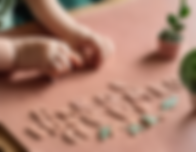
WILLOW PARK
MONTESSORI NURSERY
CURRICULUM
Our
Curriculum
The Montessori Method of Education
The curriculum offers individual and holistic learning through the Montessori method of education. This allows a programme of practical life, sensorial, language, mathematics, biology, history, science, art and music. All these topics are introduced in a way that becomes part of an exciting day. The subjects are brought to life with real materials and activities that seek to excite and stimulate little minds. There is a mixture of small group lessons and freedom for children to follow their own interests within a planned environment.
There are five major areas of curriculum in a Montessori environment that were discovered through Dr. Maria Montessori’s scientific observation of the natural tendencies children have toward learning. The five main areas of the Montessori led curriculum are, Practical Life or Everyday Living Skills, Sensorial or learning through the senses, Language and Mathematics and Culture which includes Geography, Science, Music and Art.

Practical Life activities help children gain confidence and independence by engaging in real-world tasks such as pouring, threading, polishing, food preparation, and self-care. These hands-on exercises develop coordination, concentration, motivation, and a sense of order -building essential life skills and laying the foundation for success across all Montessori areas. Children love this area because it empowers them to do meaningful, adult-like work in a child-sized environment.

The Montessori Sensorial curriculum promotes the development and refinement of the five senses. Children learn through their senses and all materials in a Montessori environment provide learning through touch, taste, smell, sight, hearing or hands-on manipulation. The Sensorial materials and curriculum create a method of learning through the senses and some examples of Sensorial learning activities are sorting objects, matching colours, matching same tastes or same smells.
The Montessori Mathematics curriculum is a powerful learning tool for developing a strong foundation in math. Dr. Maria Montessori realized that all children have a “Mathematical Mind” and that when they are given the opportunity to explore math in a concrete way, through “hands-on” materials, math become easier to understand. The Montessori Math materials cover counting, addition, subtraction and multiplication.

The Montessori Language curriculum begins with story-telling, sound games with objects, and eventually children are introduced to reading and writing. The Language curriculum is phonetic in nature and utilizes games and powerful teaching tools to help children learn.


The Montessori Culture curriculum is focused mostly on Science, Geography, Music, and Art. The Culture curriculum provides a wide array of activities including learning about the continents of the world and their uniqueness such as animals and habitats. Montessori Culture activities include pictures of the places and people of the continents, books and flags of the world. Children learn the names of the continents, oceans and countries of the world. They learn through “hands-on” materials such as puzzle maps of the world. Montessori Culture activities help to inspire a love of learning and offer children a new perspective of the world. Children’s eyes light up with the Montessori games and activities that explore far off lands, providing their imagination with more places to explore and countries to visit in the future.

Montessori education emphasises play as a child's primary work, recognising it as a powerful tool for learning and development. While Montessori environments may offer structured, hands-on activities, they also encourage self-directed exploration and free play. This approach aims to nurture a child's natural curiosity, creativity, and social skills through purposeful engagement with the environment.

Baby Room
The Baby Unit is designed to offer a calming and relaxed atmosphere coupled with a loving and caring child carer relationship. Even at this age babies are introduced to aspects of the curriculum including painting, singing and floor play. All babies are stimulated with a variety of soft play, books, musical equipment and moving colourful objects.

Classroom 2
Children aged between 2½ - 3 years begin to show their independence, wanting ‘to do everything themselves’. Expression is becoming clearer and dexterity is becoming more skilful. We encourage this self-discovery with gentle guidance, offering encouragement and praise which, in turn, builds up self-confidence and further development. Social relationships are nurtured and imagination is explored.

Classroom 1
In the Nursery Room children aged 18 months are introduced to language, expanding on their vocabulary, whilst encouraging the expansion of their social and developmental skills. Here they sing, dance, jump, paint, glue, sit, share, play and enjoy happy hours with other young children.
.png)
Classroom 3
Children from 3 years upwards become members of Classroom 3, the pre School room. At this level language skills are developed with the use of the phonic alphabet and the recognition of the written word. In the curriculum subjects are introduced to the child who is encouraged to learn the basics, subjects such as biology, history, maths, geography and science. Computer skills are introduced and foreign language learning adds an international flavour, while physical education maintains a healthy body and mind.